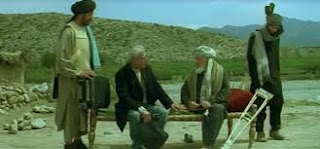Reflections of the Pakistani Film Khuda Ke Liye
The 2007 film Khuda Ke Liye, Shoaib Mansoor’s directorial debut, is a poignantly tragic drama of injustice and suffering sustained by religious extremism, cultural prejudices, and post Sept 11 paranoia. Of all the films on terrorism and Islamic fundamentalism released internationally, Khuda Ke Liye is arguably the most riveting and engaging. When Mary, a British girl of Pakistani parents, becomes friends with Dave, a white Englishman, her father, Hussain Shah, disapproves of the romance and conspires to find her a Pakistani Muslim husband. Shah deceives his daughter into returning to Pakistan, where he recruits his Lahore-based Muslim family into a plan to keep her in his native homeland. His plan receives support from his mother, passive disapproval from his brother, and the ire of his nephew, Mansoor.
The chicanery results in Mary’s forced marriage to her cousin Samrad, who, along with village elders, keeps her hostage in a backwater village in war-stricken Afghanistan. After her unsuccessful escape attempt, she succeeds in clandestinely contacting Dave, who marshals British legal and political forces to secure her release and return her to London; however, the entrenched religious and cultural forces in Pakistan baulk the Pakistani Government’s acquiescence to the British request. Ultimately, her fate rests on the persuasive powers of differing interpretations of Islam: one that can potentially free her and the other that is likely to keep her perpetually trapped in Pakistan.
Parallel to Mary’s ordeal is Mansoor’s tragedy. On migrating to the US to study music, he meets the Caucasian Janie and waivers over marrying her. Soon after conceding, he is severely tortured by American investigators, after his unjustifiable arrest from racial profiling following the September 11, 2000 terrorist attacks on the Trade Centers in New York.
Mansoor’s story does not only foreground the inescapable struggles of many diasporic Pakistani Muslims, it critiques the US security forces’ irrational demonizing of them after the incident and completes the tri-continental framing of the plot. Possibly a deeper reading of Mansoor’s fate may also reveal a subliminal critique of Westernized Muslims that feeds into notions of the inevitability of disaster and suffering accompanying their ‘misplaced’ loyalties and ‘corrupted’ values.
The narrative spatialization is one of the most unique and attractive features of the film. In London, United Kingdom, we meet Mary and agonize over her father’s hypocritical and extreme reaction to her bi-racial relationship. In Lahore, Pakistan the narrative treats us to a philosophical and ideological debate on the conflation of religion and law in procuring justice; finally, in Chicago, United States, we empathize with Janie's pain and are horrified by the annihilation of Mansoor’s human rights.
I particularly love this film for its bold and balanced representation of popular anxieties of Muslim extremism, and the irrational responses generated by the associated fears. Although less renowned globally, the film reminds me of Salman Rushdie’s novel Satanic Verses in the way in which it attempts to upend many of the radical readings of Islam. It would come as no surprise to me were a fatwa to be declared on the producer or director…knock wood!
Khuda Ke Liye is refreshing in its humane and unexcitable portrayal of Islamic extremists, not that it celebrates them, but it offers a more complex and holistic foray into their ideological trappings. The representations of the temperamentally and ideologically contrasting Maulanas provide a rich context for understanding the role of Islam in both fueling and containing anti-Western sentiments in Pakistan.
I found it ironic that while the film scores were arguable its most endearing aesthetic feature, music was also the discursive thread that tied together the ideological conflicts of the narrative. Samrad and Mansoor were the most popular musicians in Lahore, suggesting that many Pakistani Muslims appreciate music, which according to radical Islam is antithetical to the sanctity of Islam. When the radical Maulana brainwashes Samrad into abandoning his music as a religious sacrifice, it leads him to a trail of extreme behavior that distances him from his family and even himself. Alternatively, the erudite Maulana loves music, elevating it as a cherished aspect of Islamic culture.
Although much of the film settles on Islamic ideology, it also presents some powerful nationalistic discourses. The most powerful is the stereotypical portrayal of Mansoor’s and Janie’s first dyadic exchange. What appears on the surface as a corny and simplistic flirtation carries deep nationalistic and religious ideas. When Janie feigns ignorance of Pakistani Muslims, Mansoor responds “We built the Taj Mahal,” although the Taj Mahal is located in India. Despite being a historical fact, this claim by a Pakistani Muslim to India’s quintessential historic landmark has the potential to aggravate the historic religious and nationalistic conflicts between India and Pakistan. Indian Hindus are likely to be uneasy with it.
Another example of the way in which the film subtly unearths religious tensions between Indians and Pakistanis is the scene where Mansoor’s Sikh neighbor in Chicago lambasts Muslims for the widespread abuses against Muslims, Hindus, and Sikhs following the 9/11 attacks. This scene presents a critique of the perceived ignorance of the American system and highlights the intense marginalization of Muslims, not only by the West, but also by their Indian neighbors.












No comments:
Post a Comment